Comprehensive Project Plan: Railway Line Construction, Analysis
VerifiedAdded on 2020/10/22
|24
|6053
|125
Project
AI Summary
This project plan outlines the comprehensive steps involved in railway line construction. It begins with an introduction that defines the project plan and its purpose, followed by a project charter detailing the project's background, business needs, and specific goals and objectives. The plan then explores various project management methodologies, including Prince2, Agile, Waterfall, and Scrum, with a recommendation for the Prince2 methodology due to its detailed approach. It includes a scope management plan with a work breakdown structure, a requirements management plan, and a stakeholder management plan with stakeholder analysis. A risk management plan, complete with a risk register, is also provided. The plan further details schedule, communication, cost, and quality management aspects. The project activities are listed with durations, predecessors, and costs, visualized with a Gantt chart. Finally, the plan covers procurement management and concludes with references.
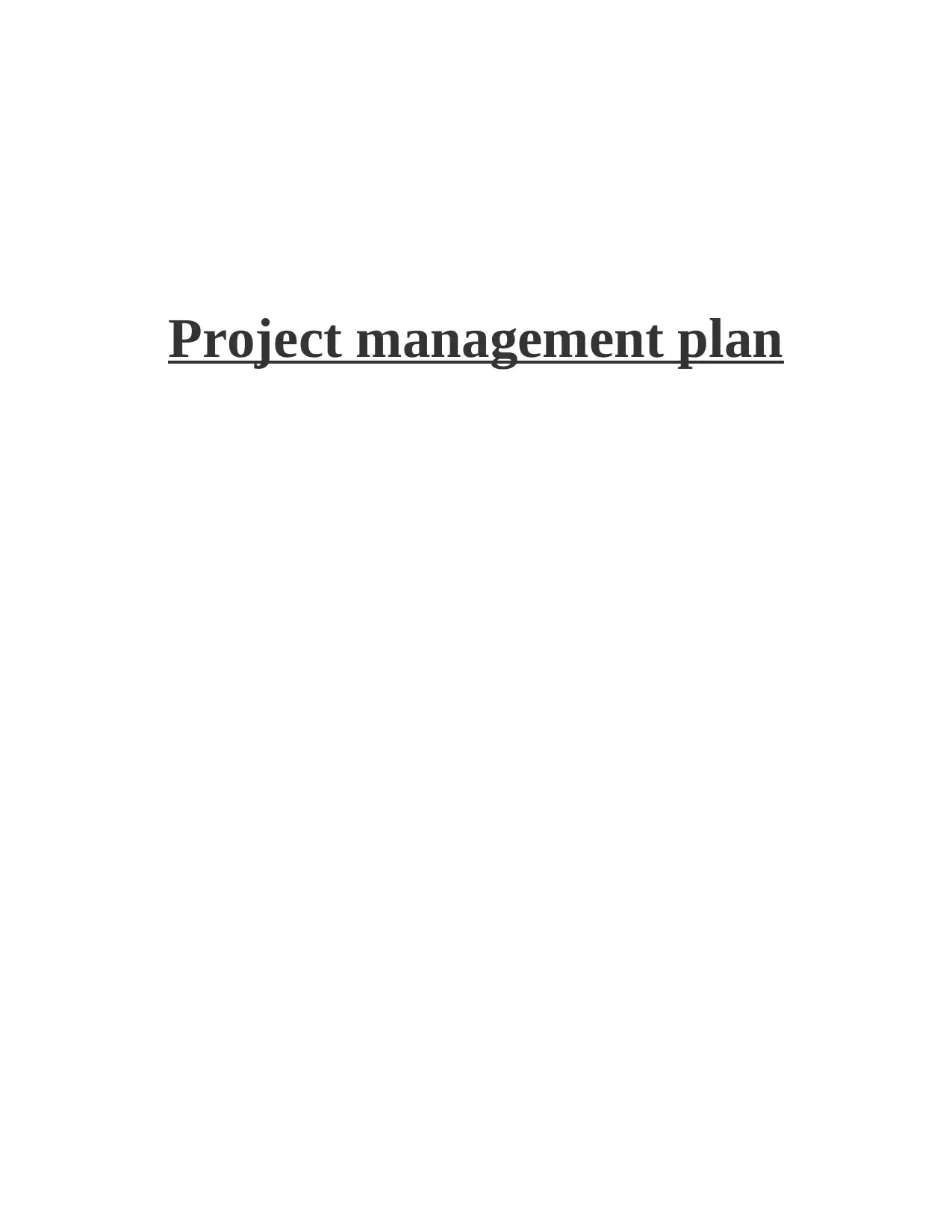
Project management plan
Paraphrase This Document
Need a fresh take? Get an instant paraphrase of this document with our AI Paraphraser
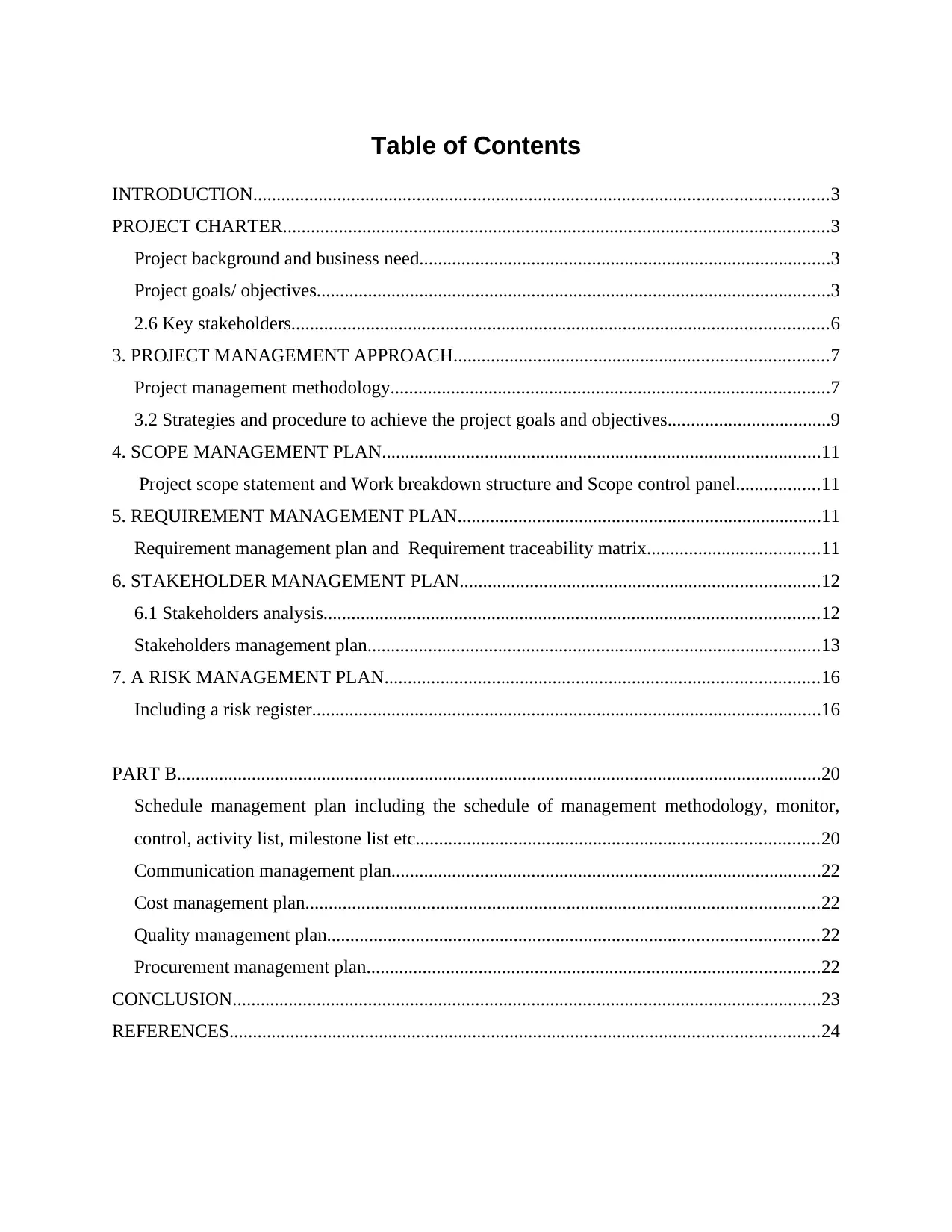
Table of Contents
INTRODUCTION...........................................................................................................................3
PROJECT CHARTER.....................................................................................................................3
Project background and business need........................................................................................3
Project goals/ objectives..............................................................................................................3
2.6 Key stakeholders...................................................................................................................6
3. PROJECT MANAGEMENT APPROACH................................................................................7
Project management methodology..............................................................................................7
3.2 Strategies and procedure to achieve the project goals and objectives...................................9
4. SCOPE MANAGEMENT PLAN..............................................................................................11
Project scope statement and Work breakdown structure and Scope control panel..................11
5. REQUIREMENT MANAGEMENT PLAN..............................................................................11
Requirement management plan and Requirement traceability matrix.....................................11
6. STAKEHOLDER MANAGEMENT PLAN.............................................................................12
6.1 Stakeholders analysis..........................................................................................................12
Stakeholders management plan.................................................................................................13
7. A RISK MANAGEMENT PLAN.............................................................................................16
Including a risk register.............................................................................................................16
PART B..........................................................................................................................................20
Schedule management plan including the schedule of management methodology, monitor,
control, activity list, milestone list etc......................................................................................20
Communication management plan............................................................................................22
Cost management plan..............................................................................................................22
Quality management plan.........................................................................................................22
Procurement management plan.................................................................................................22
CONCLUSION..............................................................................................................................23
REFERENCES..............................................................................................................................24
INTRODUCTION...........................................................................................................................3
PROJECT CHARTER.....................................................................................................................3
Project background and business need........................................................................................3
Project goals/ objectives..............................................................................................................3
2.6 Key stakeholders...................................................................................................................6
3. PROJECT MANAGEMENT APPROACH................................................................................7
Project management methodology..............................................................................................7
3.2 Strategies and procedure to achieve the project goals and objectives...................................9
4. SCOPE MANAGEMENT PLAN..............................................................................................11
Project scope statement and Work breakdown structure and Scope control panel..................11
5. REQUIREMENT MANAGEMENT PLAN..............................................................................11
Requirement management plan and Requirement traceability matrix.....................................11
6. STAKEHOLDER MANAGEMENT PLAN.............................................................................12
6.1 Stakeholders analysis..........................................................................................................12
Stakeholders management plan.................................................................................................13
7. A RISK MANAGEMENT PLAN.............................................................................................16
Including a risk register.............................................................................................................16
PART B..........................................................................................................................................20
Schedule management plan including the schedule of management methodology, monitor,
control, activity list, milestone list etc......................................................................................20
Communication management plan............................................................................................22
Cost management plan..............................................................................................................22
Quality management plan.........................................................................................................22
Procurement management plan.................................................................................................22
CONCLUSION..............................................................................................................................23
REFERENCES..............................................................................................................................24
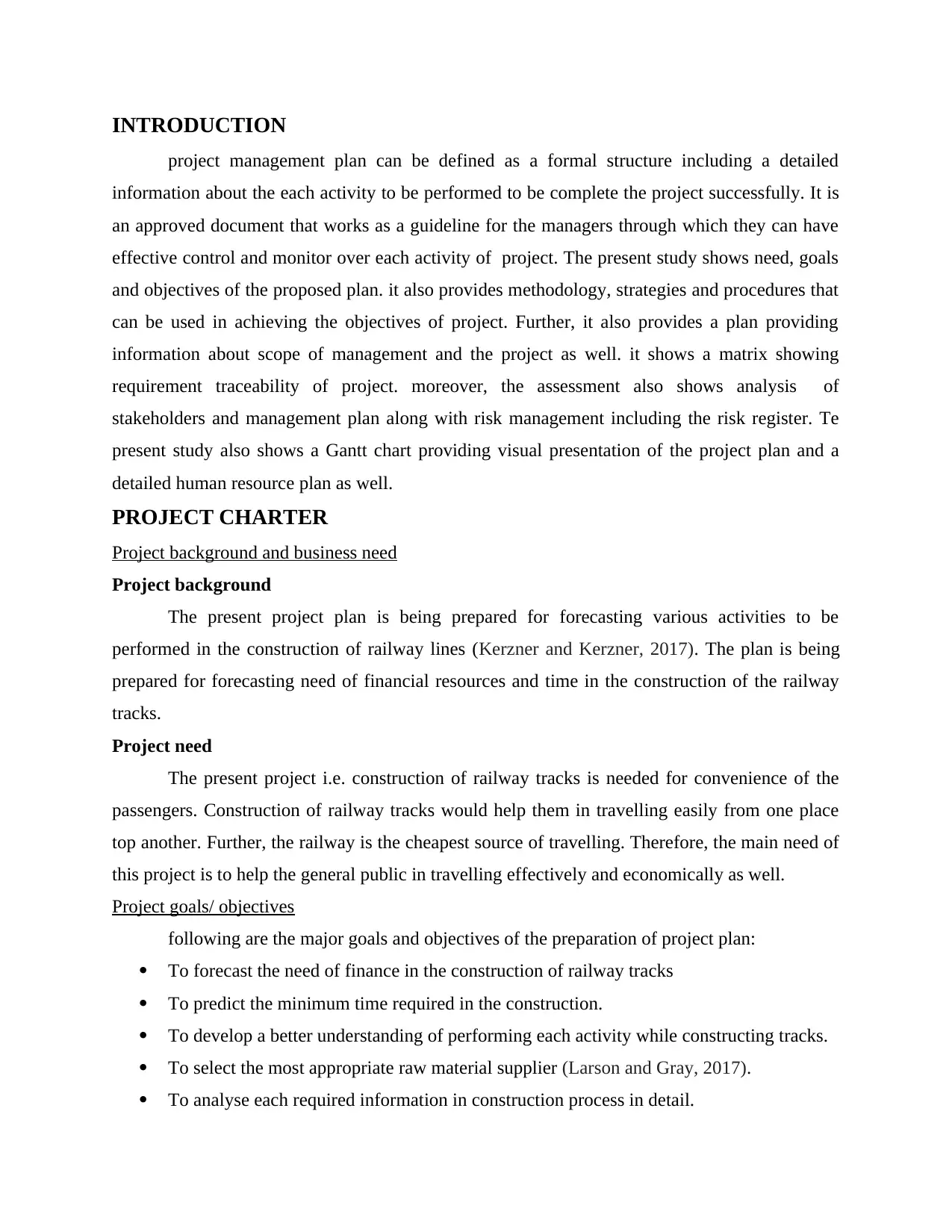
INTRODUCTION
project management plan can be defined as a formal structure including a detailed
information about the each activity to be performed to be complete the project successfully. It is
an approved document that works as a guideline for the managers through which they can have
effective control and monitor over each activity of project. The present study shows need, goals
and objectives of the proposed plan. it also provides methodology, strategies and procedures that
can be used in achieving the objectives of project. Further, it also provides a plan providing
information about scope of management and the project as well. it shows a matrix showing
requirement traceability of project. moreover, the assessment also shows analysis of
stakeholders and management plan along with risk management including the risk register. Te
present study also shows a Gantt chart providing visual presentation of the project plan and a
detailed human resource plan as well.
PROJECT CHARTER
Project background and business need
Project background
The present project plan is being prepared for forecasting various activities to be
performed in the construction of railway lines (Kerzner and Kerzner, 2017). The plan is being
prepared for forecasting need of financial resources and time in the construction of the railway
tracks.
Project need
The present project i.e. construction of railway tracks is needed for convenience of the
passengers. Construction of railway tracks would help them in travelling easily from one place
top another. Further, the railway is the cheapest source of travelling. Therefore, the main need of
this project is to help the general public in travelling effectively and economically as well.
Project goals/ objectives
following are the major goals and objectives of the preparation of project plan:
To forecast the need of finance in the construction of railway tracks
To predict the minimum time required in the construction.
To develop a better understanding of performing each activity while constructing tracks.
To select the most appropriate raw material supplier (Larson and Gray, 2017).
To analyse each required information in construction process in detail.
project management plan can be defined as a formal structure including a detailed
information about the each activity to be performed to be complete the project successfully. It is
an approved document that works as a guideline for the managers through which they can have
effective control and monitor over each activity of project. The present study shows need, goals
and objectives of the proposed plan. it also provides methodology, strategies and procedures that
can be used in achieving the objectives of project. Further, it also provides a plan providing
information about scope of management and the project as well. it shows a matrix showing
requirement traceability of project. moreover, the assessment also shows analysis of
stakeholders and management plan along with risk management including the risk register. Te
present study also shows a Gantt chart providing visual presentation of the project plan and a
detailed human resource plan as well.
PROJECT CHARTER
Project background and business need
Project background
The present project plan is being prepared for forecasting various activities to be
performed in the construction of railway lines (Kerzner and Kerzner, 2017). The plan is being
prepared for forecasting need of financial resources and time in the construction of the railway
tracks.
Project need
The present project i.e. construction of railway tracks is needed for convenience of the
passengers. Construction of railway tracks would help them in travelling easily from one place
top another. Further, the railway is the cheapest source of travelling. Therefore, the main need of
this project is to help the general public in travelling effectively and economically as well.
Project goals/ objectives
following are the major goals and objectives of the preparation of project plan:
To forecast the need of finance in the construction of railway tracks
To predict the minimum time required in the construction.
To develop a better understanding of performing each activity while constructing tracks.
To select the most appropriate raw material supplier (Larson and Gray, 2017).
To analyse each required information in construction process in detail.
⊘ This is a preview!⊘
Do you want full access?
Subscribe today to unlock all pages.

Trusted by 1+ million students worldwide
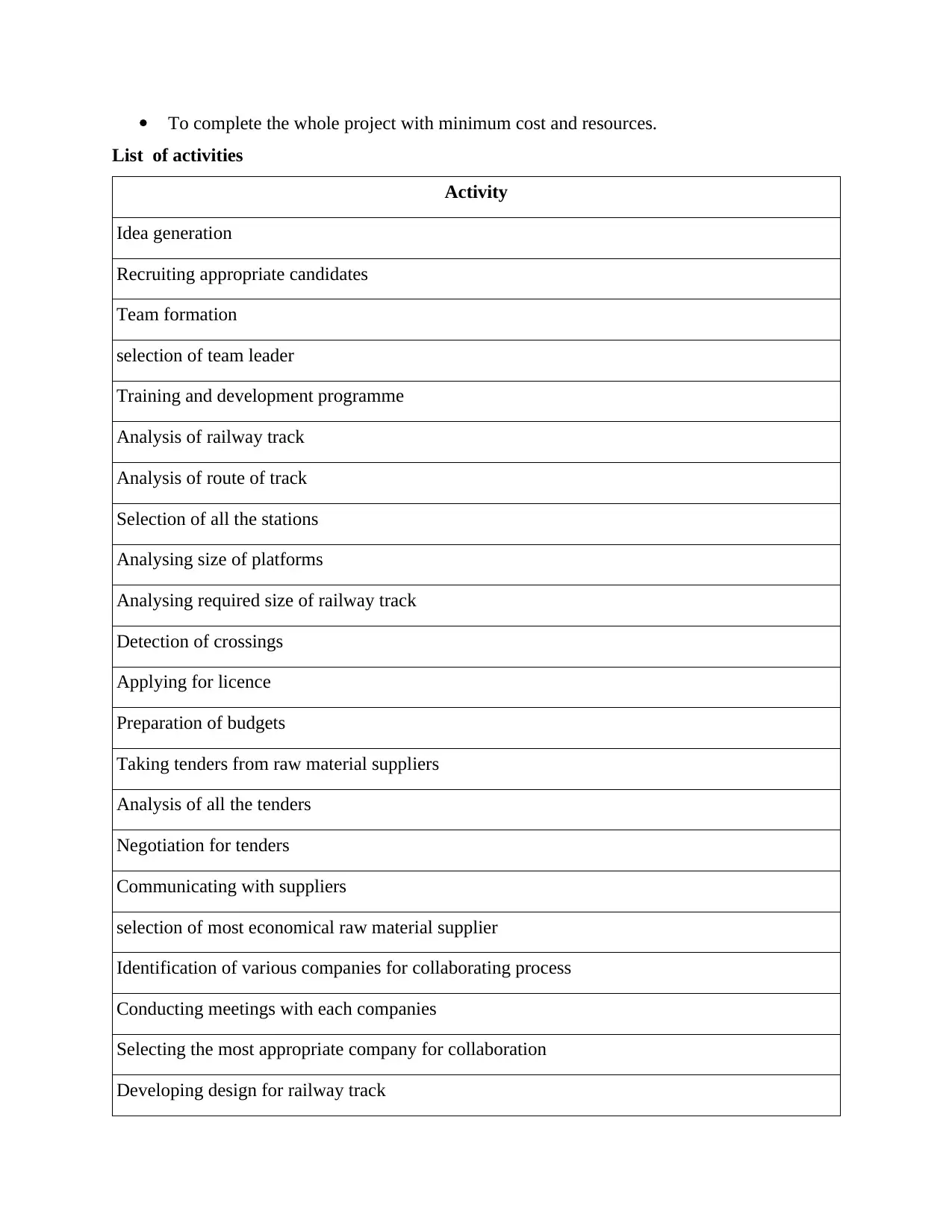
To complete the whole project with minimum cost and resources.
List of activities
Activity
Idea generation
Recruiting appropriate candidates
Team formation
selection of team leader
Training and development programme
Analysis of railway track
Analysis of route of track
Selection of all the stations
Analysing size of platforms
Analysing required size of railway track
Detection of crossings
Applying for licence
Preparation of budgets
Taking tenders from raw material suppliers
Analysis of all the tenders
Negotiation for tenders
Communicating with suppliers
selection of most economical raw material supplier
Identification of various companies for collaborating process
Conducting meetings with each companies
Selecting the most appropriate company for collaboration
Developing design for railway track
List of activities
Activity
Idea generation
Recruiting appropriate candidates
Team formation
selection of team leader
Training and development programme
Analysis of railway track
Analysis of route of track
Selection of all the stations
Analysing size of platforms
Analysing required size of railway track
Detection of crossings
Applying for licence
Preparation of budgets
Taking tenders from raw material suppliers
Analysis of all the tenders
Negotiation for tenders
Communicating with suppliers
selection of most economical raw material supplier
Identification of various companies for collaborating process
Conducting meetings with each companies
Selecting the most appropriate company for collaboration
Developing design for railway track
Paraphrase This Document
Need a fresh take? Get an instant paraphrase of this document with our AI Paraphraser
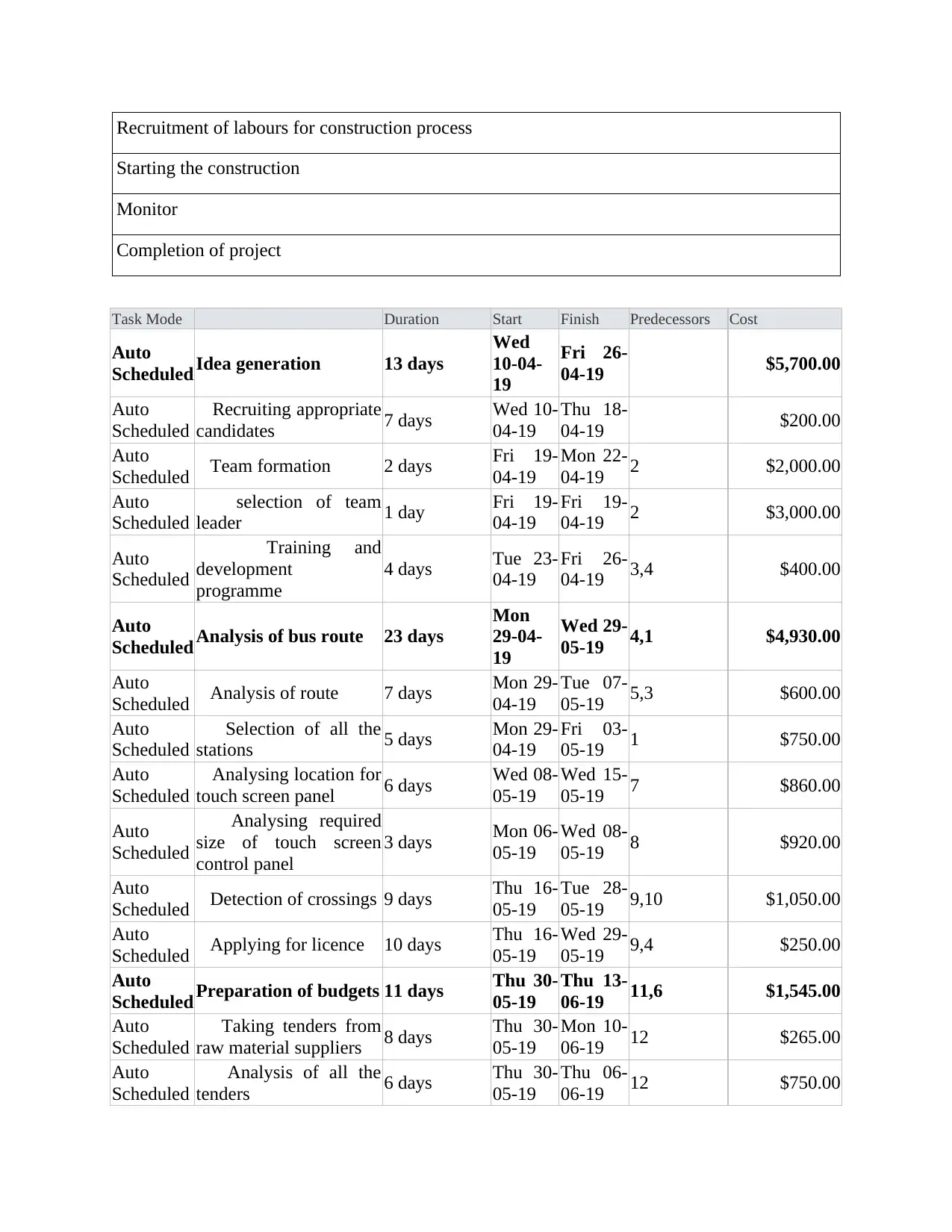
Recruitment of labours for construction process
Starting the construction
Monitor
Completion of project
Task Mode Duration Start Finish Predecessors Cost
Auto
Scheduled Idea generation 13 days
Wed
10-04-
19
Fri 26-
04-19 $5,700.00
Auto
Scheduled
Recruiting appropriate
candidates 7 days Wed 10-
04-19
Thu 18-
04-19 $200.00
Auto
Scheduled Team formation 2 days Fri 19-
04-19
Mon 22-
04-19 2 $2,000.00
Auto
Scheduled
selection of team
leader 1 day Fri 19-
04-19
Fri 19-
04-19 2 $3,000.00
Auto
Scheduled
Training and
development
programme
4 days Tue 23-
04-19
Fri 26-
04-19 3,4 $400.00
Auto
Scheduled Analysis of bus route 23 days
Mon
29-04-
19
Wed 29-
05-19 4,1 $4,930.00
Auto
Scheduled Analysis of route 7 days Mon 29-
04-19
Tue 07-
05-19 5,3 $600.00
Auto
Scheduled
Selection of all the
stations 5 days Mon 29-
04-19
Fri 03-
05-19 1 $750.00
Auto
Scheduled
Analysing location for
touch screen panel 6 days Wed 08-
05-19
Wed 15-
05-19 7 $860.00
Auto
Scheduled
Analysing required
size of touch screen
control panel
3 days Mon 06-
05-19
Wed 08-
05-19 8 $920.00
Auto
Scheduled Detection of crossings 9 days Thu 16-
05-19
Tue 28-
05-19 9,10 $1,050.00
Auto
Scheduled Applying for licence 10 days Thu 16-
05-19
Wed 29-
05-19 9,4 $250.00
Auto
Scheduled Preparation of budgets 11 days Thu 30-
05-19
Thu 13-
06-19 11,6 $1,545.00
Auto
Scheduled
Taking tenders from
raw material suppliers 8 days Thu 30-
05-19
Mon 10-
06-19 12 $265.00
Auto
Scheduled
Analysis of all the
tenders 6 days Thu 30-
05-19
Thu 06-
06-19 12 $750.00
Starting the construction
Monitor
Completion of project
Task Mode Duration Start Finish Predecessors Cost
Auto
Scheduled Idea generation 13 days
Wed
10-04-
19
Fri 26-
04-19 $5,700.00
Auto
Scheduled
Recruiting appropriate
candidates 7 days Wed 10-
04-19
Thu 18-
04-19 $200.00
Auto
Scheduled Team formation 2 days Fri 19-
04-19
Mon 22-
04-19 2 $2,000.00
Auto
Scheduled
selection of team
leader 1 day Fri 19-
04-19
Fri 19-
04-19 2 $3,000.00
Auto
Scheduled
Training and
development
programme
4 days Tue 23-
04-19
Fri 26-
04-19 3,4 $400.00
Auto
Scheduled Analysis of bus route 23 days
Mon
29-04-
19
Wed 29-
05-19 4,1 $4,930.00
Auto
Scheduled Analysis of route 7 days Mon 29-
04-19
Tue 07-
05-19 5,3 $600.00
Auto
Scheduled
Selection of all the
stations 5 days Mon 29-
04-19
Fri 03-
05-19 1 $750.00
Auto
Scheduled
Analysing location for
touch screen panel 6 days Wed 08-
05-19
Wed 15-
05-19 7 $860.00
Auto
Scheduled
Analysing required
size of touch screen
control panel
3 days Mon 06-
05-19
Wed 08-
05-19 8 $920.00
Auto
Scheduled Detection of crossings 9 days Thu 16-
05-19
Tue 28-
05-19 9,10 $1,050.00
Auto
Scheduled Applying for licence 10 days Thu 16-
05-19
Wed 29-
05-19 9,4 $250.00
Auto
Scheduled Preparation of budgets 11 days Thu 30-
05-19
Thu 13-
06-19 11,6 $1,545.00
Auto
Scheduled
Taking tenders from
raw material suppliers 8 days Thu 30-
05-19
Mon 10-
06-19 12 $265.00
Auto
Scheduled
Analysis of all the
tenders 6 days Thu 30-
05-19
Thu 06-
06-19 12 $750.00
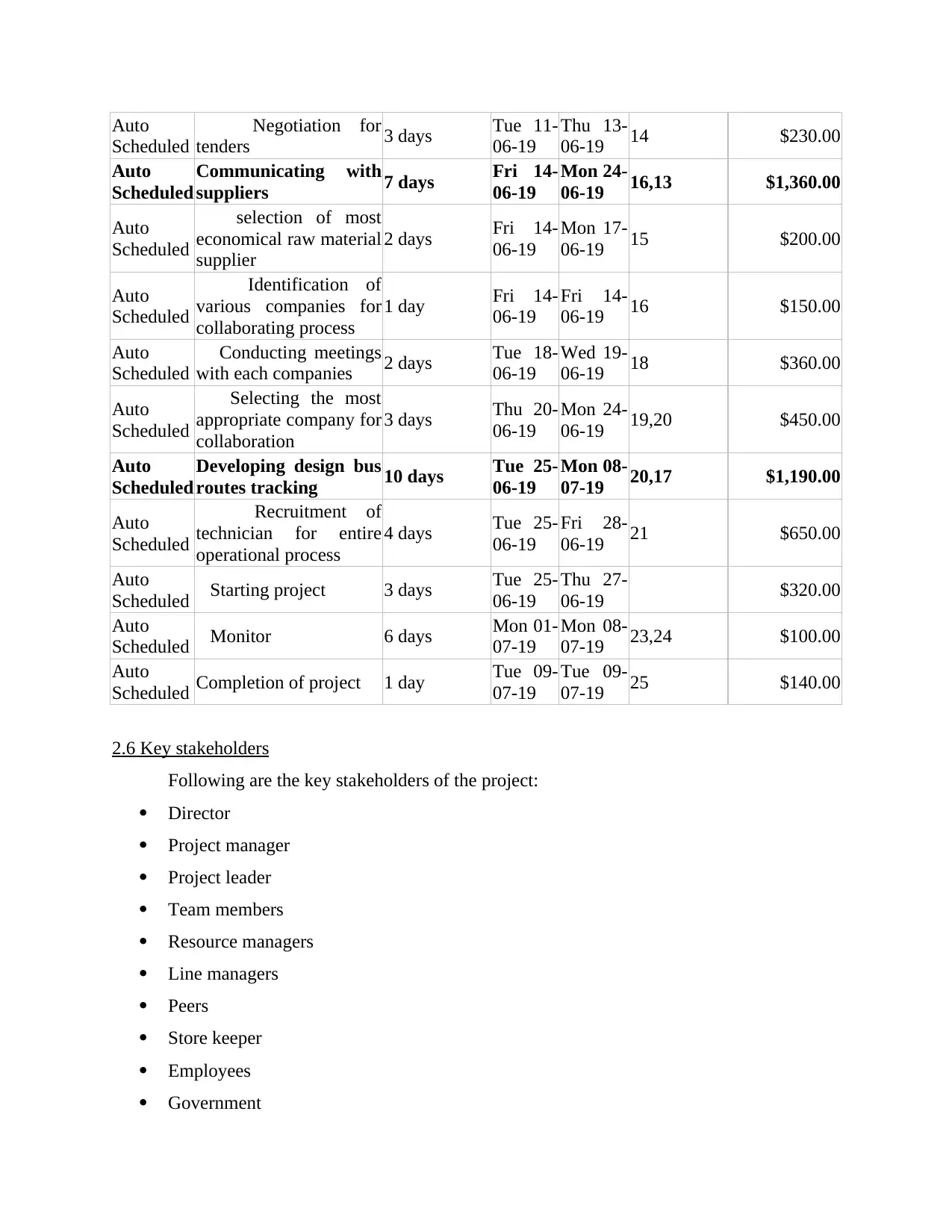
Auto
Scheduled
Negotiation for
tenders 3 days Tue 11-
06-19
Thu 13-
06-19 14 $230.00
Auto
Scheduled
Communicating with
suppliers 7 days Fri 14-
06-19
Mon 24-
06-19 16,13 $1,360.00
Auto
Scheduled
selection of most
economical raw material
supplier
2 days Fri 14-
06-19
Mon 17-
06-19 15 $200.00
Auto
Scheduled
Identification of
various companies for
collaborating process
1 day Fri 14-
06-19
Fri 14-
06-19 16 $150.00
Auto
Scheduled
Conducting meetings
with each companies 2 days Tue 18-
06-19
Wed 19-
06-19 18 $360.00
Auto
Scheduled
Selecting the most
appropriate company for
collaboration
3 days Thu 20-
06-19
Mon 24-
06-19 19,20 $450.00
Auto
Scheduled
Developing design bus
routes tracking 10 days Tue 25-
06-19
Mon 08-
07-19 20,17 $1,190.00
Auto
Scheduled
Recruitment of
technician for entire
operational process
4 days Tue 25-
06-19
Fri 28-
06-19 21 $650.00
Auto
Scheduled Starting project 3 days Tue 25-
06-19
Thu 27-
06-19 $320.00
Auto
Scheduled Monitor 6 days Mon 01-
07-19
Mon 08-
07-19 23,24 $100.00
Auto
Scheduled Completion of project 1 day Tue 09-
07-19
Tue 09-
07-19 25 $140.00
2.6 Key stakeholders
Following are the key stakeholders of the project:
Director
Project manager
Project leader
Team members
Resource managers
Line managers
Peers
Store keeper
Employees
Government
Scheduled
Negotiation for
tenders 3 days Tue 11-
06-19
Thu 13-
06-19 14 $230.00
Auto
Scheduled
Communicating with
suppliers 7 days Fri 14-
06-19
Mon 24-
06-19 16,13 $1,360.00
Auto
Scheduled
selection of most
economical raw material
supplier
2 days Fri 14-
06-19
Mon 17-
06-19 15 $200.00
Auto
Scheduled
Identification of
various companies for
collaborating process
1 day Fri 14-
06-19
Fri 14-
06-19 16 $150.00
Auto
Scheduled
Conducting meetings
with each companies 2 days Tue 18-
06-19
Wed 19-
06-19 18 $360.00
Auto
Scheduled
Selecting the most
appropriate company for
collaboration
3 days Thu 20-
06-19
Mon 24-
06-19 19,20 $450.00
Auto
Scheduled
Developing design bus
routes tracking 10 days Tue 25-
06-19
Mon 08-
07-19 20,17 $1,190.00
Auto
Scheduled
Recruitment of
technician for entire
operational process
4 days Tue 25-
06-19
Fri 28-
06-19 21 $650.00
Auto
Scheduled Starting project 3 days Tue 25-
06-19
Thu 27-
06-19 $320.00
Auto
Scheduled Monitor 6 days Mon 01-
07-19
Mon 08-
07-19 23,24 $100.00
Auto
Scheduled Completion of project 1 day Tue 09-
07-19
Tue 09-
07-19 25 $140.00
2.6 Key stakeholders
Following are the key stakeholders of the project:
Director
Project manager
Project leader
Team members
Resource managers
Line managers
Peers
Store keeper
Employees
Government
⊘ This is a preview!⊘
Do you want full access?
Subscribe today to unlock all pages.

Trusted by 1+ million students worldwide
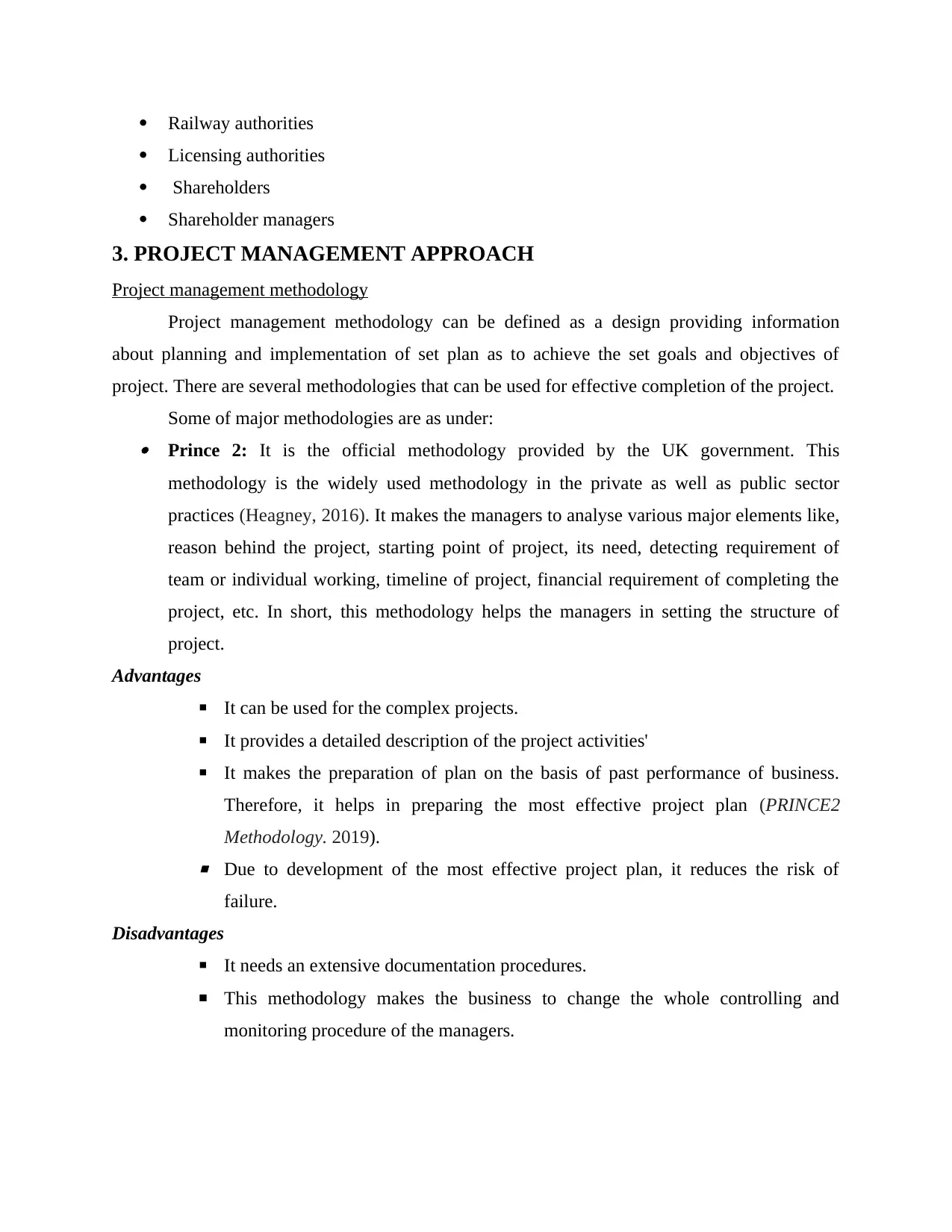
Railway authorities
Licensing authorities
Shareholders
Shareholder managers
3. PROJECT MANAGEMENT APPROACH
Project management methodology
Project management methodology can be defined as a design providing information
about planning and implementation of set plan as to achieve the set goals and objectives of
project. There are several methodologies that can be used for effective completion of the project.
Some of major methodologies are as under: Prince 2: It is the official methodology provided by the UK government. This
methodology is the widely used methodology in the private as well as public sector
practices (Heagney, 2016). It makes the managers to analyse various major elements like,
reason behind the project, starting point of project, its need, detecting requirement of
team or individual working, timeline of project, financial requirement of completing the
project, etc. In short, this methodology helps the managers in setting the structure of
project.
Advantages
▪ It can be used for the complex projects.
▪ It provides a detailed description of the project activities'
▪ It makes the preparation of plan on the basis of past performance of business.
Therefore, it helps in preparing the most effective project plan (PRINCE2
Methodology. 2019).
▪ Due to development of the most effective project plan, it reduces the risk of
failure.
Disadvantages
▪ It needs an extensive documentation procedures.
▪ This methodology makes the business to change the whole controlling and
monitoring procedure of the managers.
Licensing authorities
Shareholders
Shareholder managers
3. PROJECT MANAGEMENT APPROACH
Project management methodology
Project management methodology can be defined as a design providing information
about planning and implementation of set plan as to achieve the set goals and objectives of
project. There are several methodologies that can be used for effective completion of the project.
Some of major methodologies are as under: Prince 2: It is the official methodology provided by the UK government. This
methodology is the widely used methodology in the private as well as public sector
practices (Heagney, 2016). It makes the managers to analyse various major elements like,
reason behind the project, starting point of project, its need, detecting requirement of
team or individual working, timeline of project, financial requirement of completing the
project, etc. In short, this methodology helps the managers in setting the structure of
project.
Advantages
▪ It can be used for the complex projects.
▪ It provides a detailed description of the project activities'
▪ It makes the preparation of plan on the basis of past performance of business.
Therefore, it helps in preparing the most effective project plan (PRINCE2
Methodology. 2019).
▪ Due to development of the most effective project plan, it reduces the risk of
failure.
Disadvantages
▪ It needs an extensive documentation procedures.
▪ This methodology makes the business to change the whole controlling and
monitoring procedure of the managers.
Paraphrase This Document
Need a fresh take? Get an instant paraphrase of this document with our AI Paraphraser
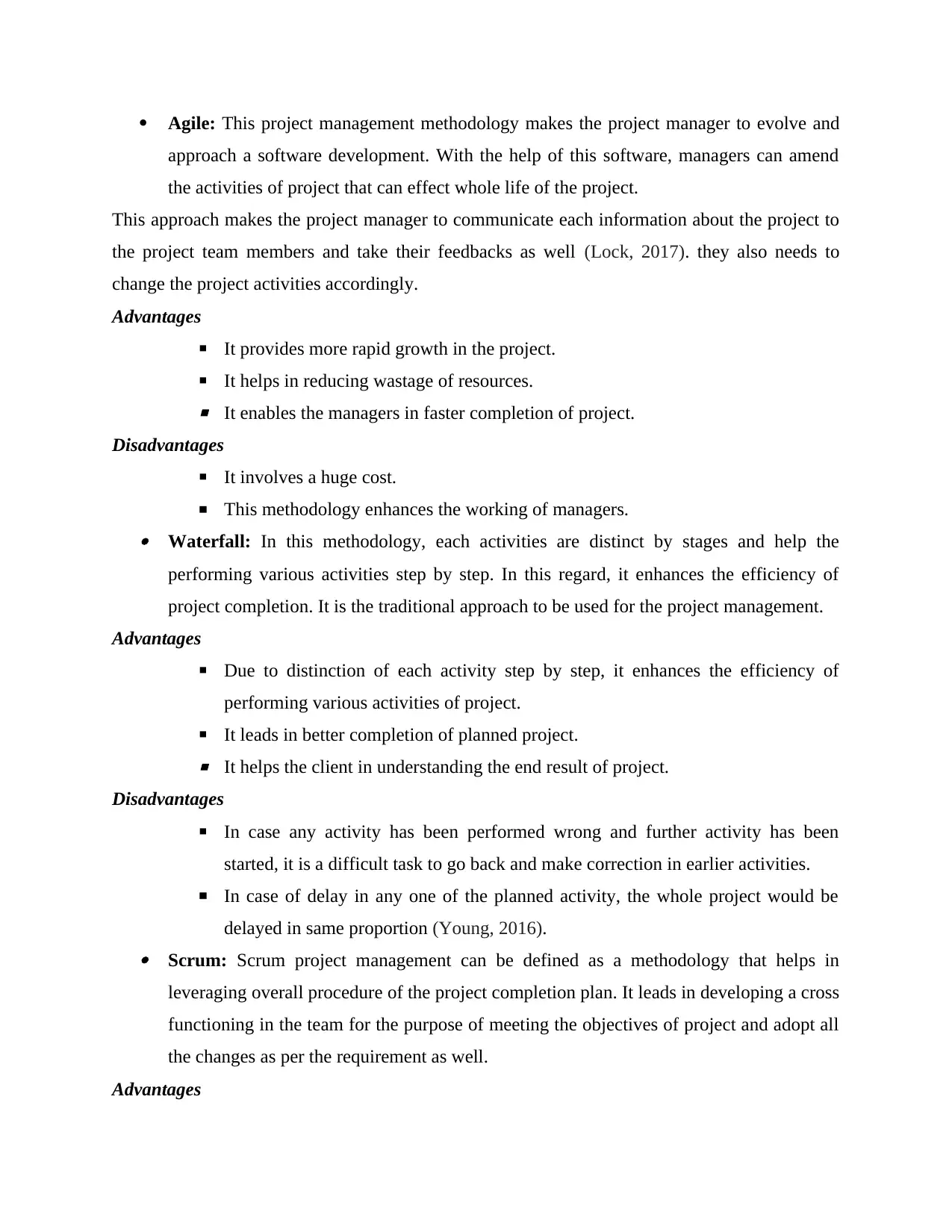
Agile: This project management methodology makes the project manager to evolve and
approach a software development. With the help of this software, managers can amend
the activities of project that can effect whole life of the project.
This approach makes the project manager to communicate each information about the project to
the project team members and take their feedbacks as well (Lock, 2017). they also needs to
change the project activities accordingly.
Advantages
▪ It provides more rapid growth in the project.
▪ It helps in reducing wastage of resources.
▪ It enables the managers in faster completion of project.
Disadvantages
▪ It involves a huge cost.
▪ This methodology enhances the working of managers. Waterfall: In this methodology, each activities are distinct by stages and help the
performing various activities step by step. In this regard, it enhances the efficiency of
project completion. It is the traditional approach to be used for the project management.
Advantages
▪ Due to distinction of each activity step by step, it enhances the efficiency of
performing various activities of project.
▪ It leads in better completion of planned project.
▪ It helps the client in understanding the end result of project.
Disadvantages
▪ In case any activity has been performed wrong and further activity has been
started, it is a difficult task to go back and make correction in earlier activities.
▪ In case of delay in any one of the planned activity, the whole project would be
delayed in same proportion (Young, 2016). Scrum: Scrum project management can be defined as a methodology that helps in
leveraging overall procedure of the project completion plan. It leads in developing a cross
functioning in the team for the purpose of meeting the objectives of project and adopt all
the changes as per the requirement as well.
Advantages
approach a software development. With the help of this software, managers can amend
the activities of project that can effect whole life of the project.
This approach makes the project manager to communicate each information about the project to
the project team members and take their feedbacks as well (Lock, 2017). they also needs to
change the project activities accordingly.
Advantages
▪ It provides more rapid growth in the project.
▪ It helps in reducing wastage of resources.
▪ It enables the managers in faster completion of project.
Disadvantages
▪ It involves a huge cost.
▪ This methodology enhances the working of managers. Waterfall: In this methodology, each activities are distinct by stages and help the
performing various activities step by step. In this regard, it enhances the efficiency of
project completion. It is the traditional approach to be used for the project management.
Advantages
▪ Due to distinction of each activity step by step, it enhances the efficiency of
performing various activities of project.
▪ It leads in better completion of planned project.
▪ It helps the client in understanding the end result of project.
Disadvantages
▪ In case any activity has been performed wrong and further activity has been
started, it is a difficult task to go back and make correction in earlier activities.
▪ In case of delay in any one of the planned activity, the whole project would be
delayed in same proportion (Young, 2016). Scrum: Scrum project management can be defined as a methodology that helps in
leveraging overall procedure of the project completion plan. It leads in developing a cross
functioning in the team for the purpose of meeting the objectives of project and adopt all
the changes as per the requirement as well.
Advantages
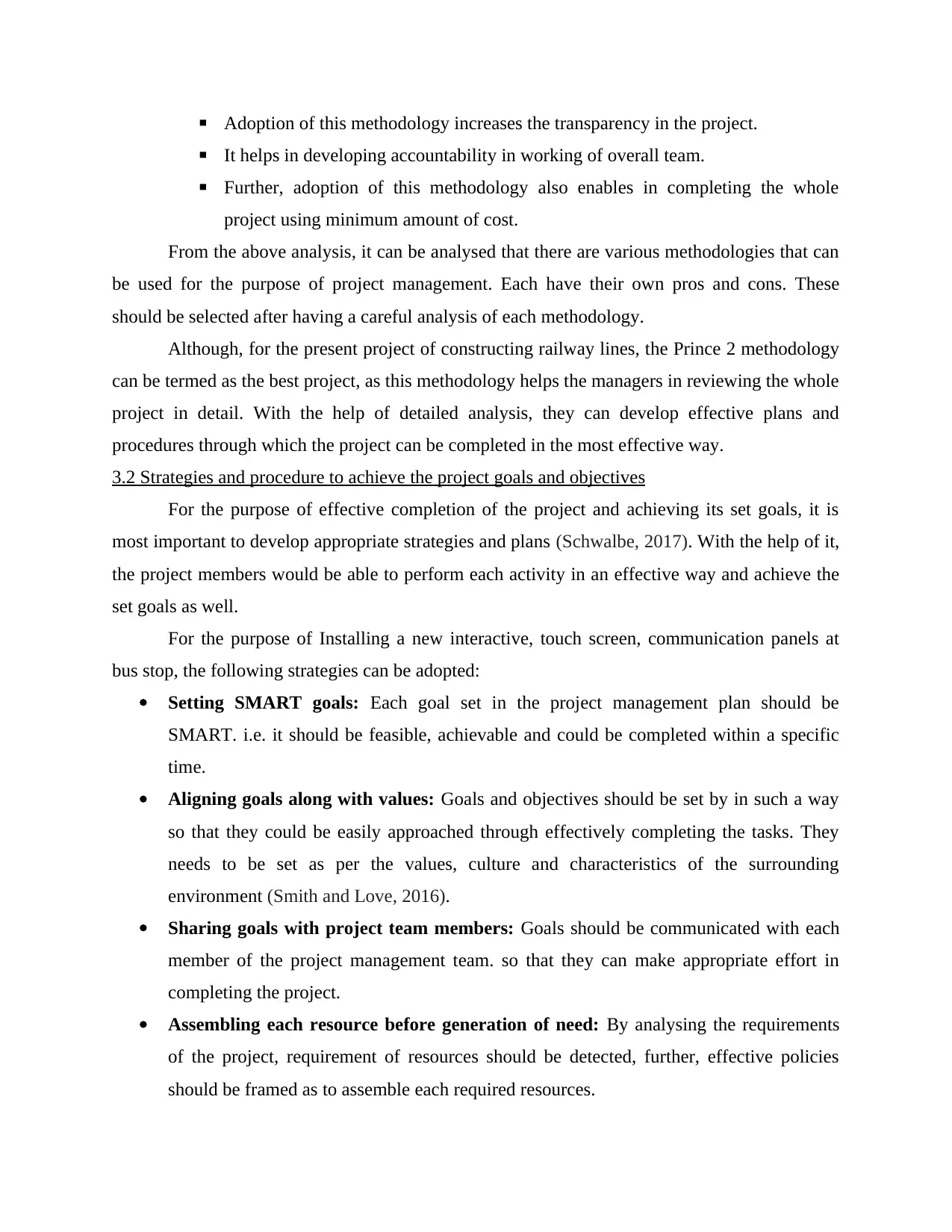
▪ Adoption of this methodology increases the transparency in the project.
▪ It helps in developing accountability in working of overall team.
▪ Further, adoption of this methodology also enables in completing the whole
project using minimum amount of cost.
From the above analysis, it can be analysed that there are various methodologies that can
be used for the purpose of project management. Each have their own pros and cons. These
should be selected after having a careful analysis of each methodology.
Although, for the present project of constructing railway lines, the Prince 2 methodology
can be termed as the best project, as this methodology helps the managers in reviewing the whole
project in detail. With the help of detailed analysis, they can develop effective plans and
procedures through which the project can be completed in the most effective way.
3.2 Strategies and procedure to achieve the project goals and objectives
For the purpose of effective completion of the project and achieving its set goals, it is
most important to develop appropriate strategies and plans (Schwalbe, 2017). With the help of it,
the project members would be able to perform each activity in an effective way and achieve the
set goals as well.
For the purpose of Installing a new interactive, touch screen, communication panels at
bus stop, the following strategies can be adopted:
Setting SMART goals: Each goal set in the project management plan should be
SMART. i.e. it should be feasible, achievable and could be completed within a specific
time.
Aligning goals along with values: Goals and objectives should be set by in such a way
so that they could be easily approached through effectively completing the tasks. They
needs to be set as per the values, culture and characteristics of the surrounding
environment (Smith and Love, 2016).
Sharing goals with project team members: Goals should be communicated with each
member of the project management team. so that they can make appropriate effort in
completing the project.
Assembling each resource before generation of need: By analysing the requirements
of the project, requirement of resources should be detected, further, effective policies
should be framed as to assemble each required resources.
▪ It helps in developing accountability in working of overall team.
▪ Further, adoption of this methodology also enables in completing the whole
project using minimum amount of cost.
From the above analysis, it can be analysed that there are various methodologies that can
be used for the purpose of project management. Each have their own pros and cons. These
should be selected after having a careful analysis of each methodology.
Although, for the present project of constructing railway lines, the Prince 2 methodology
can be termed as the best project, as this methodology helps the managers in reviewing the whole
project in detail. With the help of detailed analysis, they can develop effective plans and
procedures through which the project can be completed in the most effective way.
3.2 Strategies and procedure to achieve the project goals and objectives
For the purpose of effective completion of the project and achieving its set goals, it is
most important to develop appropriate strategies and plans (Schwalbe, 2017). With the help of it,
the project members would be able to perform each activity in an effective way and achieve the
set goals as well.
For the purpose of Installing a new interactive, touch screen, communication panels at
bus stop, the following strategies can be adopted:
Setting SMART goals: Each goal set in the project management plan should be
SMART. i.e. it should be feasible, achievable and could be completed within a specific
time.
Aligning goals along with values: Goals and objectives should be set by in such a way
so that they could be easily approached through effectively completing the tasks. They
needs to be set as per the values, culture and characteristics of the surrounding
environment (Smith and Love, 2016).
Sharing goals with project team members: Goals should be communicated with each
member of the project management team. so that they can make appropriate effort in
completing the project.
Assembling each resource before generation of need: By analysing the requirements
of the project, requirement of resources should be detected, further, effective policies
should be framed as to assemble each required resources.
⊘ This is a preview!⊘
Do you want full access?
Subscribe today to unlock all pages.

Trusted by 1+ million students worldwide
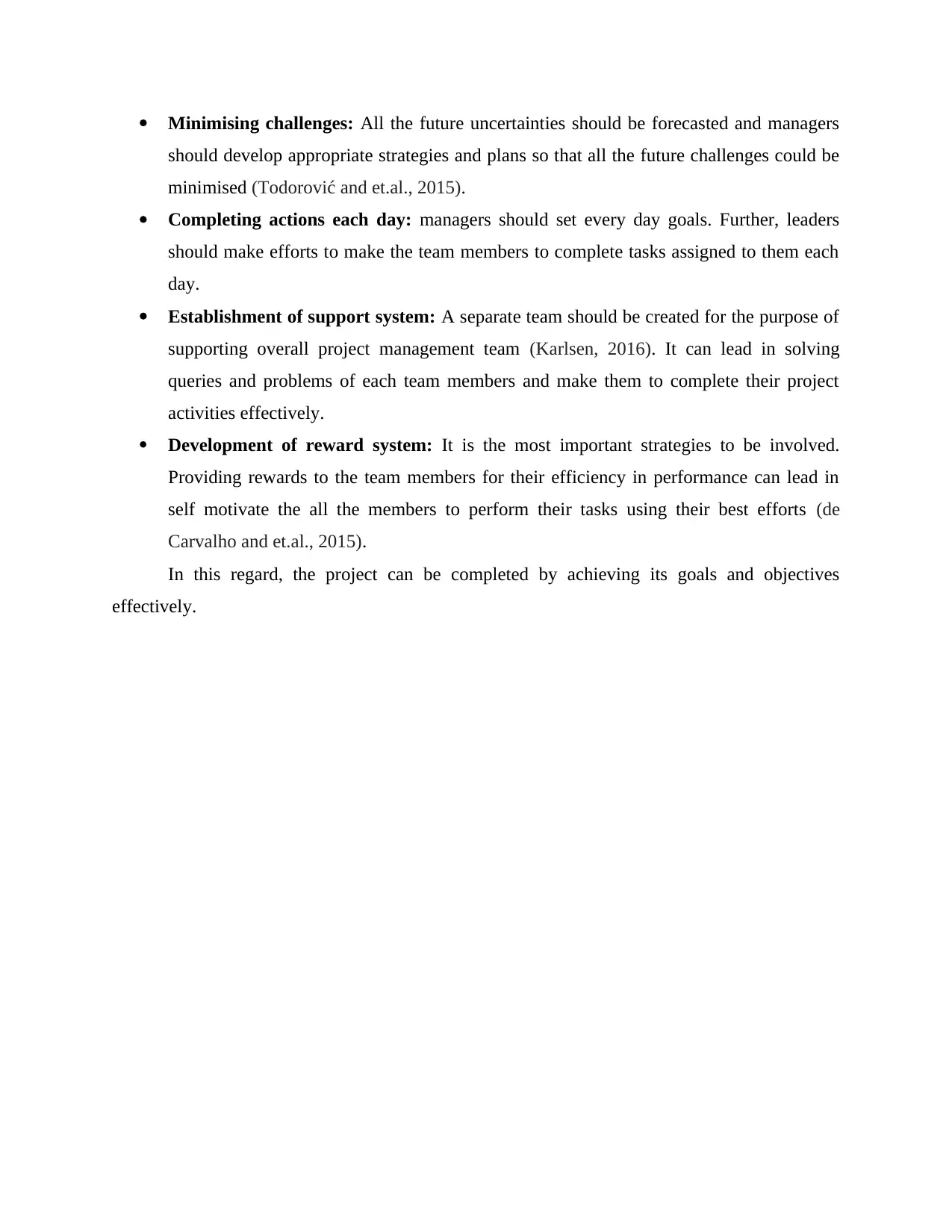
Minimising challenges: All the future uncertainties should be forecasted and managers
should develop appropriate strategies and plans so that all the future challenges could be
minimised (Todorović and et.al., 2015).
Completing actions each day: managers should set every day goals. Further, leaders
should make efforts to make the team members to complete tasks assigned to them each
day.
Establishment of support system: A separate team should be created for the purpose of
supporting overall project management team (Karlsen, 2016). It can lead in solving
queries and problems of each team members and make them to complete their project
activities effectively.
Development of reward system: It is the most important strategies to be involved.
Providing rewards to the team members for their efficiency in performance can lead in
self motivate the all the members to perform their tasks using their best efforts (de
Carvalho and et.al., 2015).
In this regard, the project can be completed by achieving its goals and objectives
effectively.
should develop appropriate strategies and plans so that all the future challenges could be
minimised (Todorović and et.al., 2015).
Completing actions each day: managers should set every day goals. Further, leaders
should make efforts to make the team members to complete tasks assigned to them each
day.
Establishment of support system: A separate team should be created for the purpose of
supporting overall project management team (Karlsen, 2016). It can lead in solving
queries and problems of each team members and make them to complete their project
activities effectively.
Development of reward system: It is the most important strategies to be involved.
Providing rewards to the team members for their efficiency in performance can lead in
self motivate the all the members to perform their tasks using their best efforts (de
Carvalho and et.al., 2015).
In this regard, the project can be completed by achieving its goals and objectives
effectively.
Paraphrase This Document
Need a fresh take? Get an instant paraphrase of this document with our AI Paraphraser
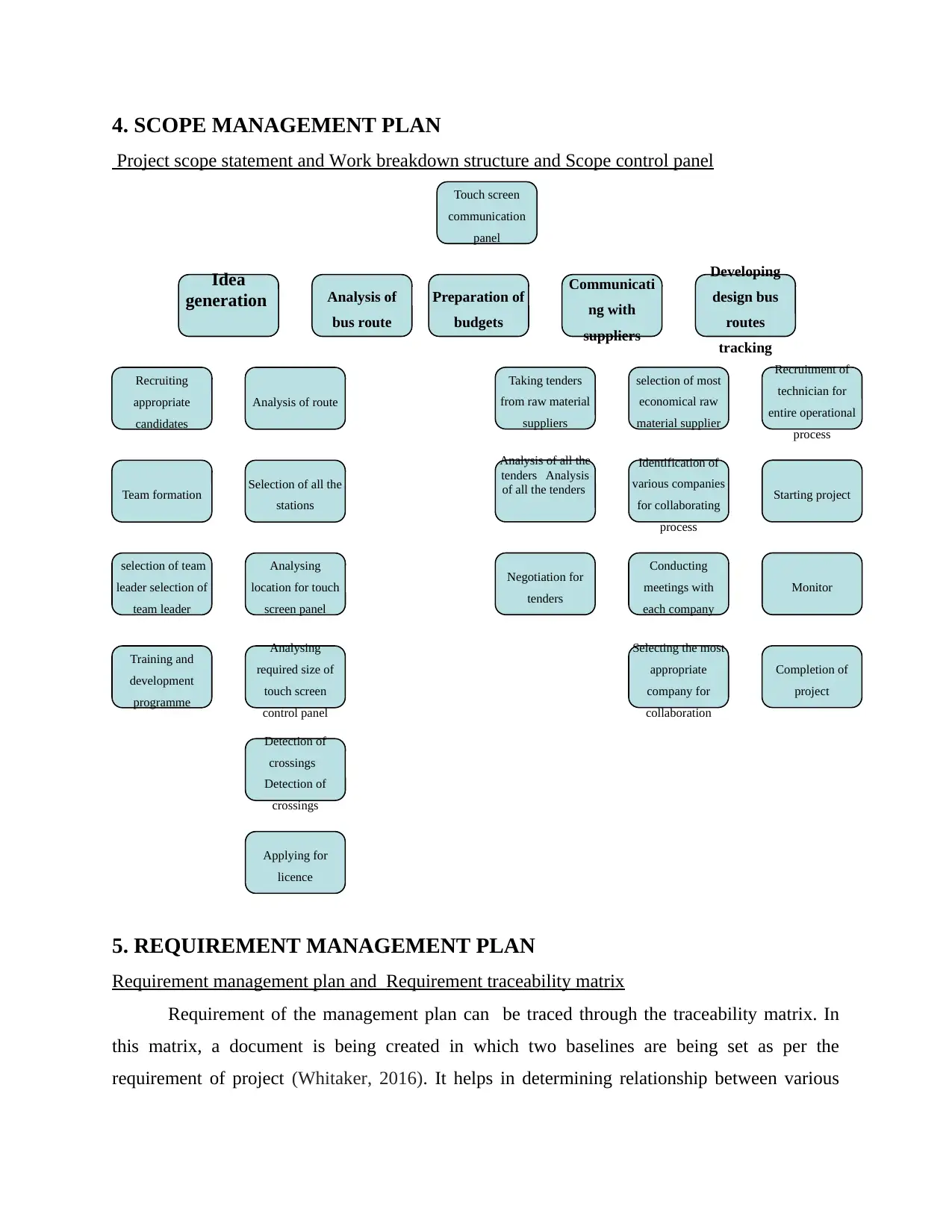
4. SCOPE MANAGEMENT PLAN
Project scope statement and Work breakdown structure and Scope control panel
5. REQUIREMENT MANAGEMENT PLAN
Requirement management plan and Requirement traceability matrix
Requirement of the management plan can be traced through the traceability matrix. In
this matrix, a document is being created in which two baselines are being set as per the
requirement of project (Whitaker, 2016). It helps in determining relationship between various
Touch screen
communication
panel
Idea
generation
Developing
design bus
routes
tracking
Communicati
ng with
suppliers
Preparation of
budgets
Analysis of
bus route
Recruiting
appropriate
candidates
Team formation
selection of team
leader selection of
team leader
Training and
development
programme
Analysis of route
Selection of all the
stations
Analysing
location for touch
screen panel
Analysing
required size of
touch screen
control panel
Detection of
crossings
Detection of
crossings
Applying for
licence
Taking tenders
from raw material
suppliers
Analysis of all the
tenders Analysis
of all the tenders
Negotiation for
tenders
selection of most
economical raw
material supplier
Identification of
various companies
for collaborating
process
Conducting
meetings with
each company
Selecting the most
appropriate
company for
collaboration
Recruitment of
technician for
entire operational
process
Starting project
Monitor
Completion of
project
Project scope statement and Work breakdown structure and Scope control panel
5. REQUIREMENT MANAGEMENT PLAN
Requirement management plan and Requirement traceability matrix
Requirement of the management plan can be traced through the traceability matrix. In
this matrix, a document is being created in which two baselines are being set as per the
requirement of project (Whitaker, 2016). It helps in determining relationship between various
Touch screen
communication
panel
Idea
generation
Developing
design bus
routes
tracking
Communicati
ng with
suppliers
Preparation of
budgets
Analysis of
bus route
Recruiting
appropriate
candidates
Team formation
selection of team
leader selection of
team leader
Training and
development
programme
Analysis of route
Selection of all the
stations
Analysing
location for touch
screen panel
Analysing
required size of
touch screen
control panel
Detection of
crossings
Detection of
crossings
Applying for
licence
Taking tenders
from raw material
suppliers
Analysis of all the
tenders Analysis
of all the tenders
Negotiation for
tenders
selection of most
economical raw
material supplier
Identification of
various companies
for collaborating
process
Conducting
meetings with
each company
Selecting the most
appropriate
company for
collaboration
Recruitment of
technician for
entire operational
process
Starting project
Monitor
Completion of
project
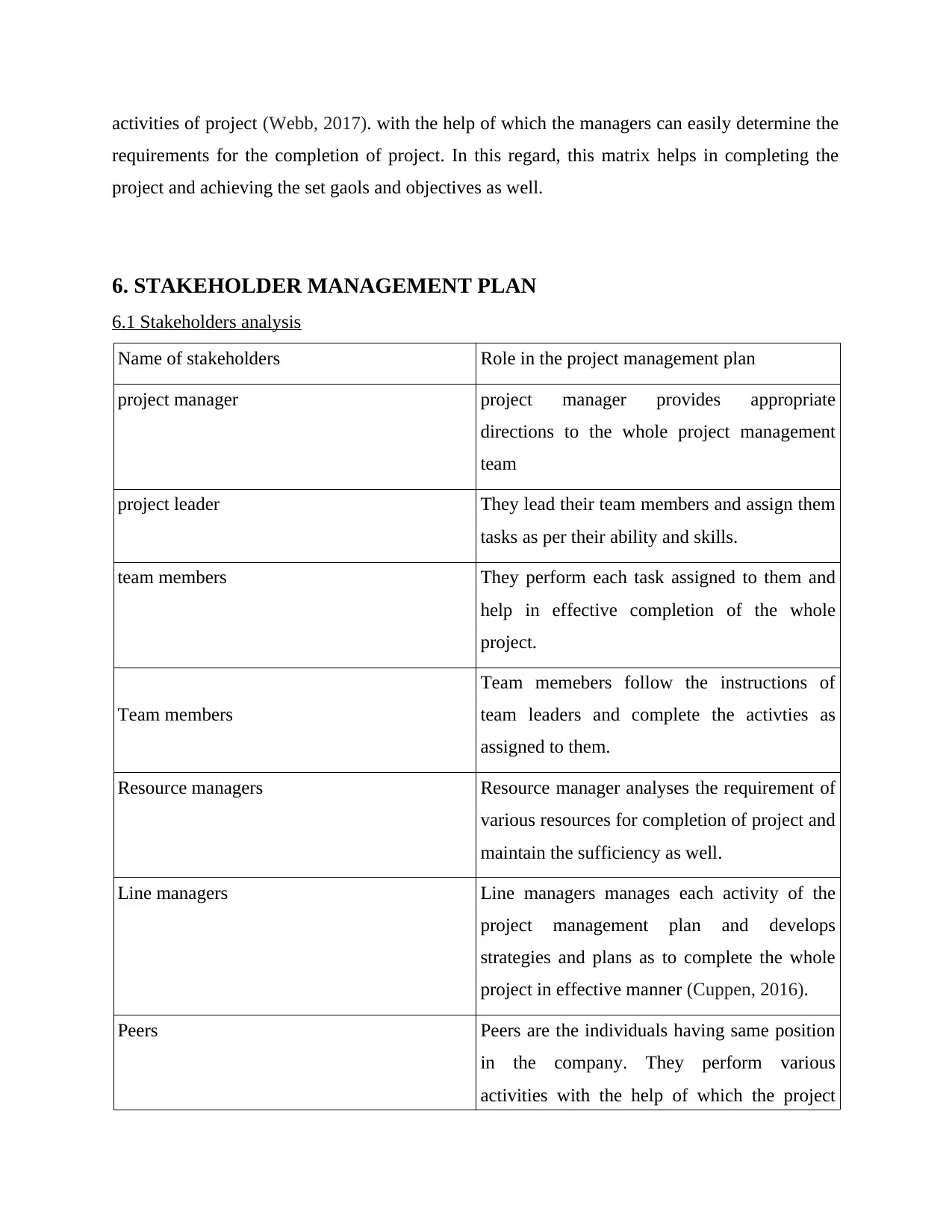
activities of project (Webb, 2017). with the help of which the managers can easily determine the
requirements for the completion of project. In this regard, this matrix helps in completing the
project and achieving the set gaols and objectives as well.
6. STAKEHOLDER MANAGEMENT PLAN
6.1 Stakeholders analysis
Name of stakeholders Role in the project management plan
project manager project manager provides appropriate
directions to the whole project management
team
project leader They lead their team members and assign them
tasks as per their ability and skills.
team members They perform each task assigned to them and
help in effective completion of the whole
project.
Team members
Team memebers follow the instructions of
team leaders and complete the activties as
assigned to them.
Resource managers Resource manager analyses the requirement of
various resources for completion of project and
maintain the sufficiency as well.
Line managers Line managers manages each activity of the
project management plan and develops
strategies and plans as to complete the whole
project in effective manner (Cuppen, 2016).
Peers Peers are the individuals having same position
in the company. They perform various
activities with the help of which the project
requirements for the completion of project. In this regard, this matrix helps in completing the
project and achieving the set gaols and objectives as well.
6. STAKEHOLDER MANAGEMENT PLAN
6.1 Stakeholders analysis
Name of stakeholders Role in the project management plan
project manager project manager provides appropriate
directions to the whole project management
team
project leader They lead their team members and assign them
tasks as per their ability and skills.
team members They perform each task assigned to them and
help in effective completion of the whole
project.
Team members
Team memebers follow the instructions of
team leaders and complete the activties as
assigned to them.
Resource managers Resource manager analyses the requirement of
various resources for completion of project and
maintain the sufficiency as well.
Line managers Line managers manages each activity of the
project management plan and develops
strategies and plans as to complete the whole
project in effective manner (Cuppen, 2016).
Peers Peers are the individuals having same position
in the company. They perform various
activities with the help of which the project
⊘ This is a preview!⊘
Do you want full access?
Subscribe today to unlock all pages.

Trusted by 1+ million students worldwide
1 out of 24
Related Documents
Your All-in-One AI-Powered Toolkit for Academic Success.
+13062052269
info@desklib.com
Available 24*7 on WhatsApp / Email
![[object Object]](/_next/static/media/star-bottom.7253800d.svg)
Unlock your academic potential
Copyright © 2020–2025 A2Z Services. All Rights Reserved. Developed and managed by ZUCOL.




